DODGE TRUCK 1993 Service Repair Manual
Manufacturer: DODGE, Model Year: 1993, Model line: TRUCK, Model: DODGE TRUCK 1993Pages: 1502, PDF Size: 80.97 MB
Page 1181 of 1502
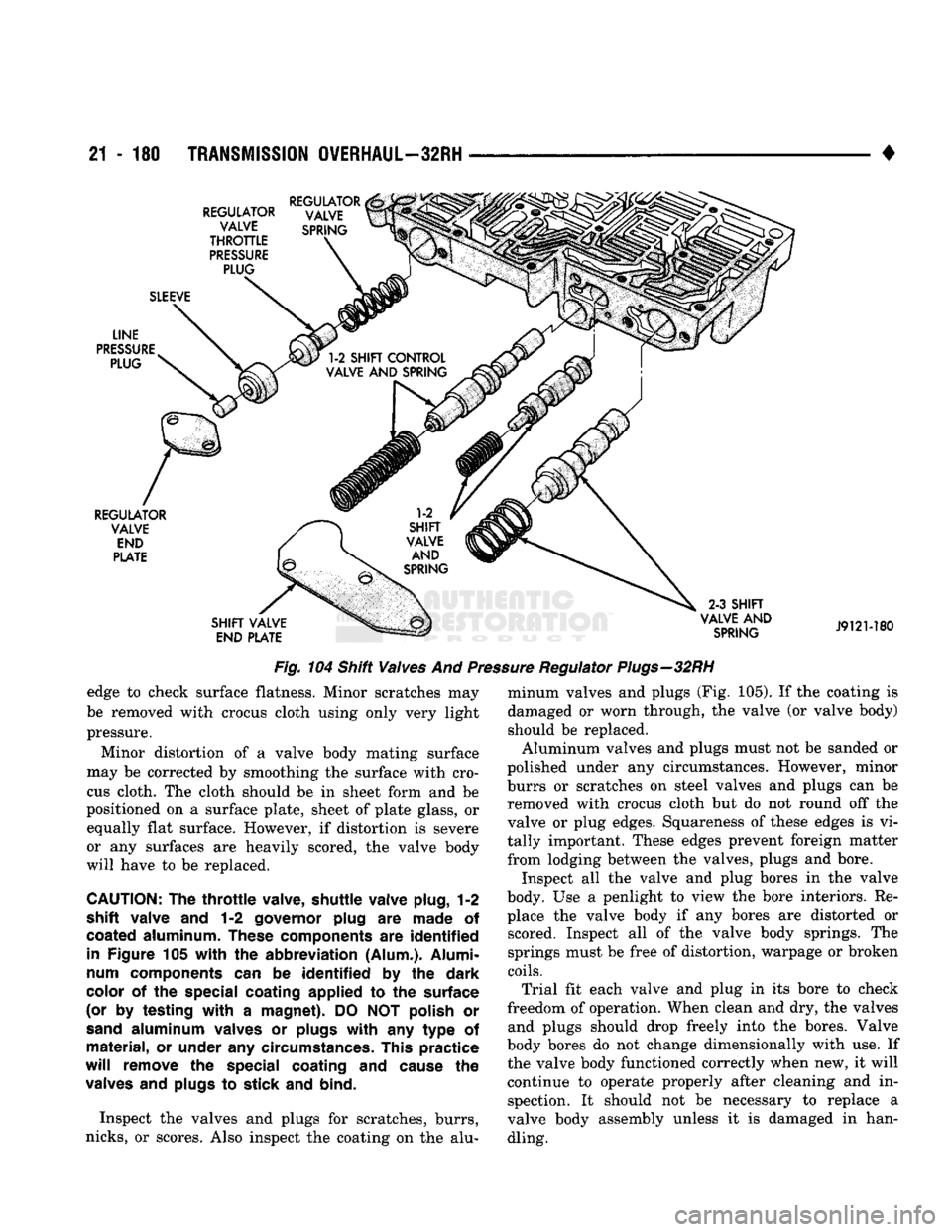
21
- 180
TRANSMISSION OVERHAUL—32RH
•
REGULATOR VALVE
THROTTLE
PRESSURE
PLUG REGULATOR
VALVE
SPRING
SLEEVE
LINE
PRESSURE
PLUG
REGULATOR VALVE END
PLATE
SHIFT
VALVE END PLATE
2-3 SHIFT
VALVE
AND
SPRING
J912M80
Fig. 104 Shift Valves And Pressure Regulator Plugs—32RH
edge to check surface flatness. Minor scratches may
be removed with crocus cloth using only very light pressure.
Minor distortion of a valve body mating surface
may be corrected by smoothing the surface with cro
cus cloth. The cloth should be in sheet form and be
positioned on a surface plate, sheet of plate glass, or equally flat surface. However, if distortion is severe
or any surfaces are heavily scored, the valve body
will have to be replaced.
CAUTION:
The
throttle
valve, shuttle valve plug,
1-2
shift valve
and 1-2
governor plug
are
made
of
coated
aluminum.
These
components are
identified
in Figure
105
with
the
abbreviation (Alum.). Alumi
num components
can be
identified
by the
dark
color
of the
special coating applied
to the
surface
(or
by
testing
with
a
magnet).
DO NOT
polish
or
sand
aluminum valves
or
plugs
with
any
type
of
material,
or
under
any
circumstances. This practice
will
remove the special
coating
and
cause
the
valves
and
plugs
to
stick
and
bind.
Inspect the valves and plugs for scratches, burrs,
nicks,
or scores. Also inspect the coating on the alu minum valves and plugs (Fig. 105). If the coating is
damaged or worn through, the valve (or valve body)
should be replaced. Aluminum valves and plugs must not be sanded or
polished under any circumstances. However, minor
burrs or scratches on steel valves and plugs can be removed with crocus cloth but do not round off the
valve or plug edges. Squareness of these edges is vi
tally important. These edges prevent foreign matter from lodging between the valves, plugs and bore.
Inspect all the valve and plug bores in the valve
body. Use a penlight to view the bore interiors. Re place the valve body if any bores are distorted or scored. Inspect all of the valve body springs. The
springs must be free of distortion, warpage or broken
coils.
Trial fit each valve and plug in its bore to check
freedom of operation. When clean and dry, the valves and plugs should drop freely into the bores. Valve
body bores do not change dimensionally with use. If the valve body functioned correctly when new, it will
continue to operate properly after cleaning and inspection. It should not be necessary to replace a
valve body assembly unless it is damaged in handling.
Page 1182 of 1502
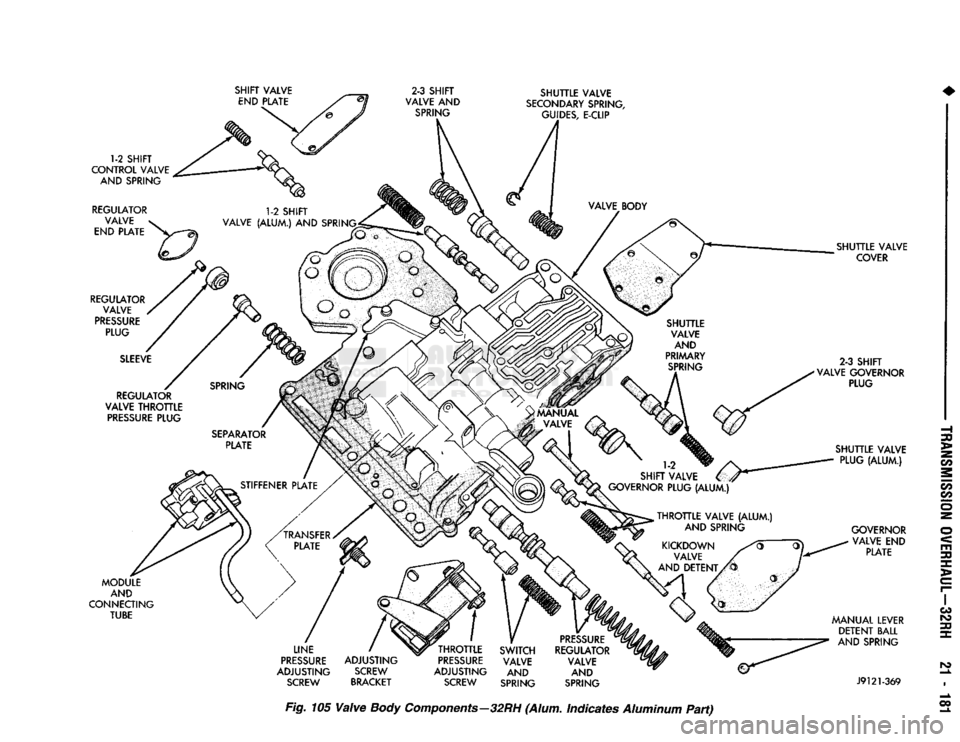
SHIFT VALVE
END PLATE 2-3 SHIFT
VALVE
AND
SPRING SHUTTLE VALVE
SECONDARY SPRING, GUIDES,
E-CLIP
1-2 SHIFT
CONTROL VALVE AND SPRING
REGULATOR VALVE
END PLATE
REGULATOR VALVE
PRESSURE PLUG
SLEEVE
MODULE AND
CONNECTING
TUBE SHUTTLE VALVE
COVER
REGULATOR
VALVE THROTTLE PRESSURE PLUG
LINE
PRESSURE
ADJUSTING SCREW ADJUSTING
SCREW
BRACKET THROTTLE
PRESSURE
ADJUSTING SCREW SWITCH
VALVE AND
SPRING PRESSURE
REGULATOR VALVE AND
SPRING
2-3
SHIFT
VALVE GOVERNOR PLUG
SHUTTLE VALVE PLUG (ALUM.)
GOVERNOR VALVE
END
PLATE
MANUAL LEVER DETENT BALL
AND SPRING
J9121-369
Fig. 105
Valve
Body Components—32RH (Alum.
Indicates
Aluminum
Part)
Page 1183 of 1502
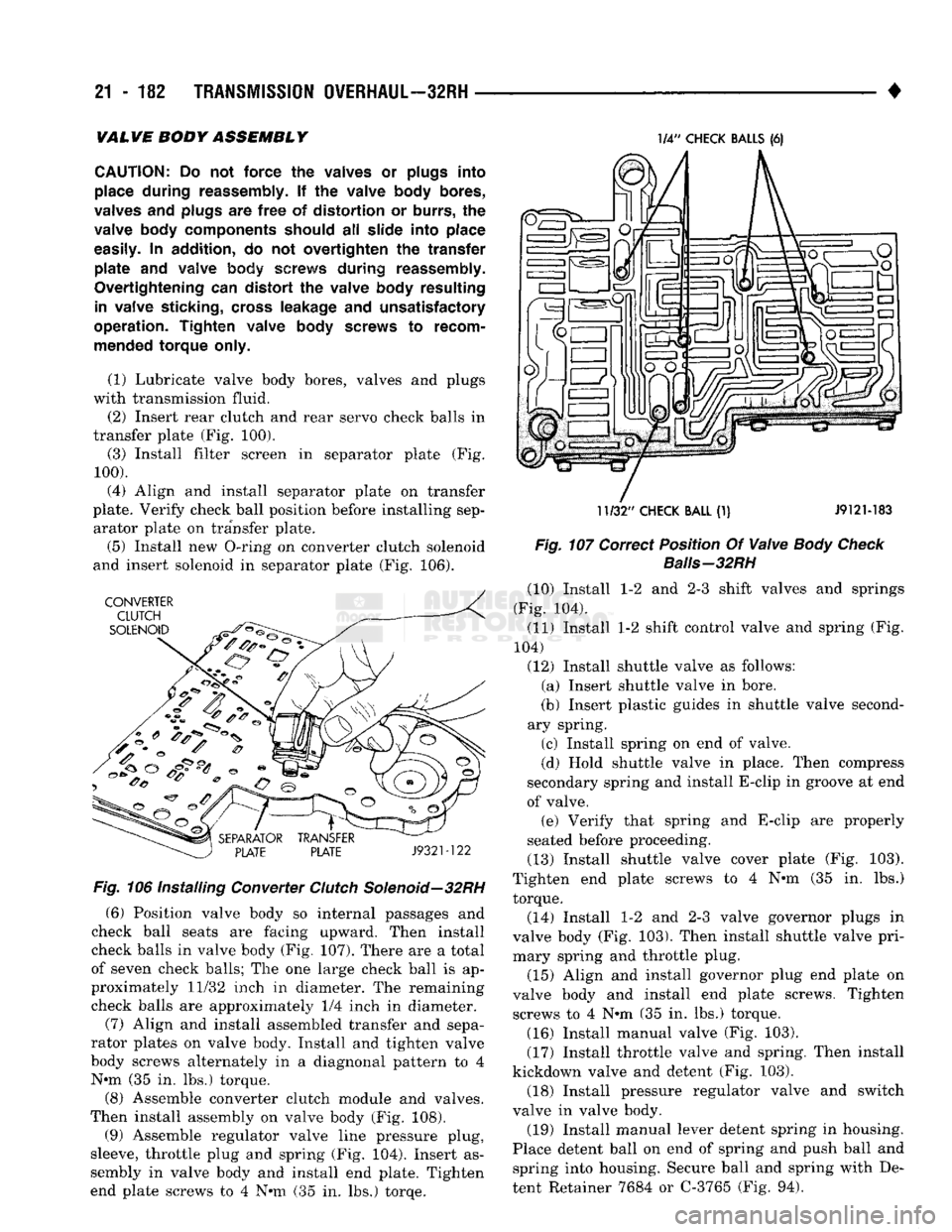
21
- 182
TRANSMISSION OVERHAUL—32RH
• VAL VE
BODY
ASSEMBL
Y
CAUTION:
Do not
force
the valves or plugs
into
place
during
reassembly. If the valve body
bores,
valves
and plugs are
free
of
distortion
or burrs, the
valve body components should all slide
into
place
easily. In
addition,
do not
overtighten
the
transfer
plate
and valve body
screws
during
reassembly.
Overtightening
can
distort
the valve body
resulting
in valve sticking,
cross
leakage and
unsatisfactory
operation. Tighten valve body
screws
to recom mended
torque
only.
(1) Lubricate valve body bores, valves and plugs
with transmission fluid.
(2) Insert rear clutch and rear servo check balls in
transfer plate (Fig. 100).
(3) Install filter screen in separator plate (Fig.
100).
(4) Align and install separator plate on transfer
plate. Verify check ball position before installing sep arator plate on transfer plate.
(5) Install new O-ring on converter clutch solenoid
and insert solenoid in separator plate (Fig. 106). Fig. 106
Installing
Converter
Clutch
Solenoid—32RH
(6) Position valve body so internal passages and
check ball seats are facing upward. Then install
check balls in valve body (Fig. 107). There are a total
of seven check balls; The one large check ball is ap
proximately 11/32 inch in diameter. The remaining
check balls are approximately 1/4 inch in diameter.
(7) Align and install assembled transfer and sepa
rator plates on valve body. Install and tighten valve
body screws alternately in a diagnonal pattern to 4 N»m (35 in. lbs.) torque.
(8) Assemble converter clutch module and valves.
Then install assembly on valve body (Fig. 108).
(9) Assemble regulator valve line pressure plug,
sleeve, throttle plug and spring (Fig. 104). Insert as
sembly in valve body and install end plate. Tighten
end plate screws to 4 N»m (35 in. lbs.) torqe. 1/4"
CHECK
BALLS
(6)
11/32"
CHECK
BALL
(1) J912M83
Fig. 107
Correct
Position
Of
Valve
Body Check
Baiis-32RH
(10) Install 1-2 and 2-3 shift valves and springs
(Fig. 104).
(11) Install 1-2 shift control valve and spring (Fig.
104)
(12) Install shuttle valve as follows: (a) Insert shuttle valve in bore.
(b) Insert plastic guides in shuttle valve second
ary spring.
(c) Install spring on end of valve.
(d) Hold shuttle valve in place. Then compress
secondary spring and install E-clip in groove at end
of valve. (e) Verify that spring and E-clip are properly
seated before proceeding.
(13) Install shuttle valve cover plate (Fig. 103).
Tighten end plate screws to 4 N»m (35 in. lbs.)
torque.
(14) Install 1-2 and 2-3 valve governor plugs in
valve body (Fig. 103). Then install shuttle valve pri
mary spring and throttle plug.
(15) Align and install governor plug end plate on
valve body and install end plate screws. Tighten screws to 4 N*m (35 in. lbs.) torque.
(16) Install manual valve (Fig. 103).
(17) Install throttle valve and spring. Then install
kickdown valve and detent (Fig. 103).
(18) Install pressure regulator valve and switch
valve in valve body.
(19) Install manual lever detent spring in housing.
Place detent ball on end of spring and push ball and spring into housing. Secure ball and spring with De
tent Retainer 7684 or C-3765 (Fig. 94).
Page 1184 of 1502
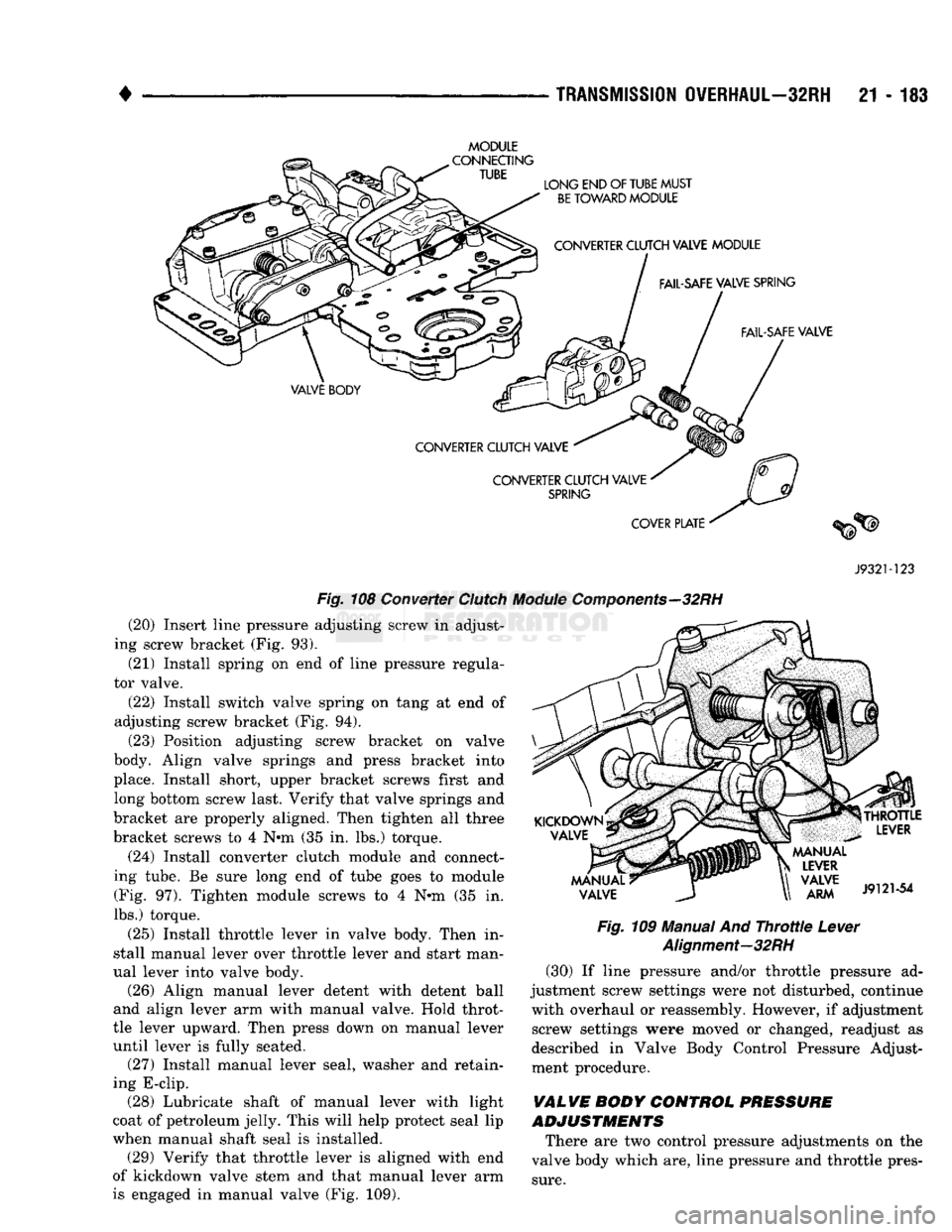
•
TRANSMISSION
OVERHAUL—32RH
21 - 183
MODULE
J932M23
Fig.
108 Converter
Clutch
Module
Components—32RH
(20) Insert line pressure adjusting screw in adjust
ing screw bracket (Fig. 93).
(21) Install spring on end of line pressure regula
tor valve.
(22) Install switch valve spring on tang at end of
adjusting screw bracket (Fig. 94).
(23) Position adjusting screw bracket on valve
body. Align valve springs and press bracket into
place. Install short, upper bracket screws first and long bottom screw last. Verify that valve springs and
bracket are properly aligned. Then tighten all three
bracket screws to 4 N*m (35 in. lbs.) torque.
(24) Install converter clutch module and connect
ing tube. Be sure long end of tube goes to module (Fig. 97). Tighten module screws to 4 Nrn (35 in.
lbs.) torque.
(25) Install throttle lever in valve body. Then in
stall manual lever over throttle lever and start man
ual lever into valve body. (26) Align manual lever detent with detent ball
and align lever arm with manual valve. Hold throt
tle lever upward. Then press down on manual lever
until lever is fully seated. (27) Install manual lever seal, washer and retain
ing E-clip. (28) Lubricate shaft of manual lever with light
coat of petroleum jelly. This will help protect seal lip
when manual shaft seal is installed. (29) Verify that throttle lever is aligned with end
of kickdown valve stem and that manual lever arm
is engaged in manual valve (Fig. 109).
Fig.
109 Manual And
Throttle
Lever
Alignment—32RH
(30) If line pressure and/or throttle pressure ad
justment screw settings were not disturbed, continue with overhaul or reassembly. However, if adjustment screw settings were moved or changed, readjust as
described in Valve Body Control Pressure Adjust
ment procedure.
VALVE BODY CONTROL PRESSURE
ADJUSTMENTS
There are two control pressure adjustments on the
valve body which are, line pressure and throttle pres
sure.
Page 1185 of 1502
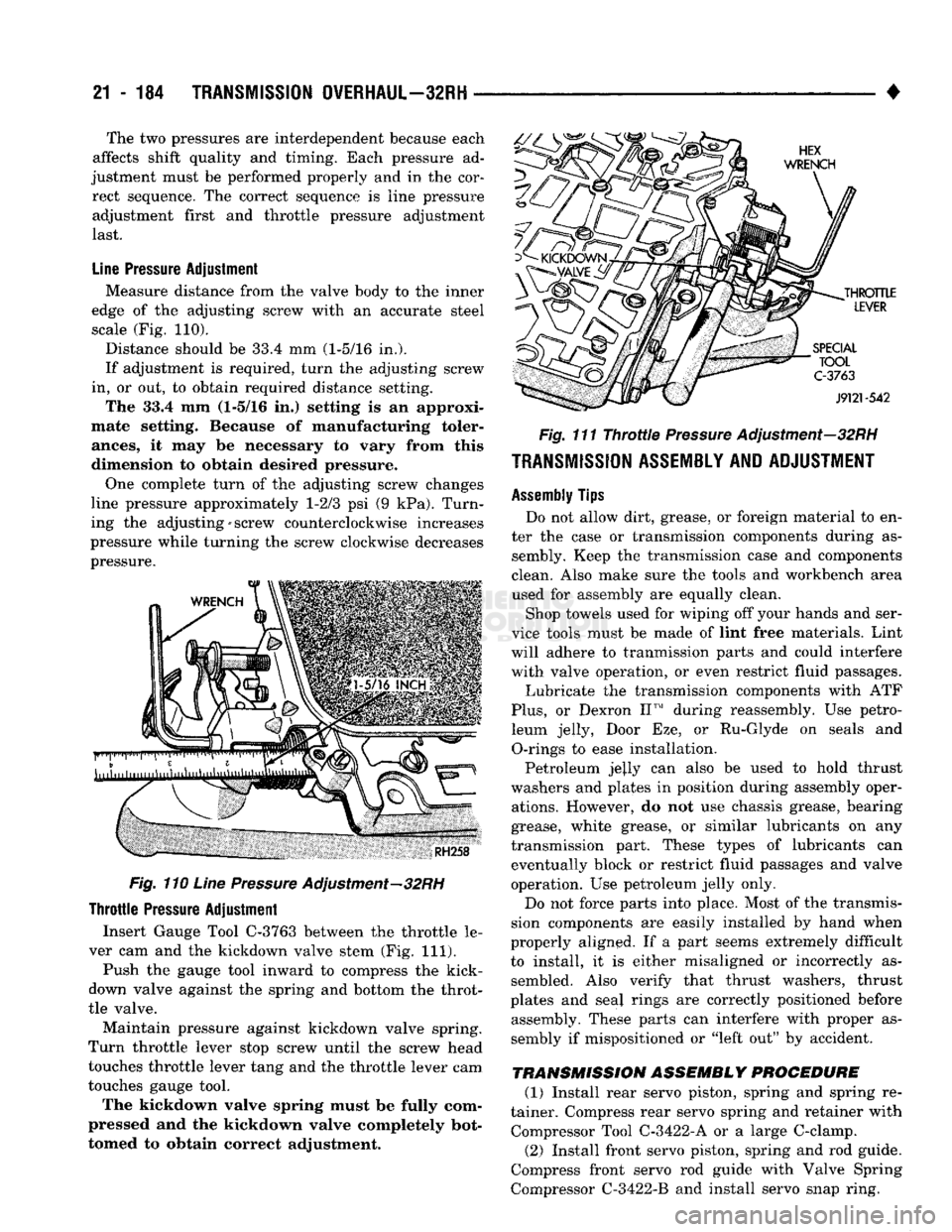
21 - 184
TRANSMISSION
OVERHAUL—32RH
-
Fig. 110 Line Pressure Adjustment—32RH
Throttle
Pressure
Adjustment
Insert Gauge Tool C-3763 between the throttle le
ver cam and the kickdown valve stem (Fig. 111).
Push the gauge tool inward to compress the kick-
down valve against the spring and bottom the throt
tle valve.
Maintain pressure against kickdown valve spring.
Turn throttle lever stop screw until the screw head
touches throttle lever tang and the throttle lever cam
touches gauge tool.
The kickdown valve spring must be fully com
pressed and the kickdown valve completely bot
tomed to obtain correct adjustment.
•
Fig. 111 Throttle Pressure Adjustment—32RH
TRANSMISSION ASSEMBLY AND ADJUSTMENT
Assembly
Tips
Do not allow dirt, grease, or foreign material to en
ter the case or transmission components during as sembly. Keep the transmission case and components
clean. Also make sure the tools and workbench area
used for assembly are equally clean.
Shop towels used for wiping off your hands and ser
vice tools must be made of lint free materials. Lint
will adhere to tranmission parts and could interfere with valve operation, or even restrict fluid passages.
Lubricate the transmission components with ATF
Plus,
or Dexron II™ during reassembly. Use petro leum jelly, Door Eze, or Ru-Glyde on seals and O-rings to ease installation.
Petroleum jejly can also be used to hold thrust
washers and plates in position during assembly oper ations. However, do not use chassis grease, bearing
grease, white grease, or similar lubricants on any
transmission part. These types of lubricants can eventually block or restrict fluid passages and valve
operation. Use petroleum jelly only.
Do not force parts into place. Most of the transmis
sion components are easily installed by hand when
properly aligned. If a part seems extremely difficult
to install, it is either misaligned or incorrectly as sembled. Also verify that thrust washers, thrust
plates and seal rings are correctly positioned before assembly. These parts can interfere with proper as
sembly if mispositioned or "left out" by accident.
TRANSMISSION
ASSEMBLY PROCEDURE (1) Install rear servo piston, spring and spring re
tainer. Compress rear servo spring and retainer with Compressor Tool C-3422-A or a large C-clamp.
(2) Install front servo piston, spring and rod guide.
Compress front servo rod guide with Valve Spring
Compressor C-3422-B and install servo snap ring.
The two pressures are interdependent because each
affects shift quality and timing. Each pressure ad
justment must be performed properly and in the cor rect sequence. The correct sequence is line pressure adjustment first and throttle pressure adjustment
last.
Line
Pressure
Adjustment
Measure distance from the valve body to the inner
edge of the adjusting screw with an accurate steel
scale (Fig. 110).
Distance should be 33.4 mm (1-5/16 in.).
If adjustment is required, turn the adjusting screw
in, or out, to obtain required distance setting.
The 33.4 mm (1-5/16 in,) setting Is an approxi
mate setting. Because of manufacturing toler
ances,
it may be necessary to vary from this
dimension to obtain desired pressure.
One complete turn of the adjusting screw changes
line pressure approximately 1-2/3 psi (9 kPa). Turn
ing the adjusting-screw counterclockwise increases
pressure while turning the screw clockwise decreases
pressure.
Page 1186 of 1502
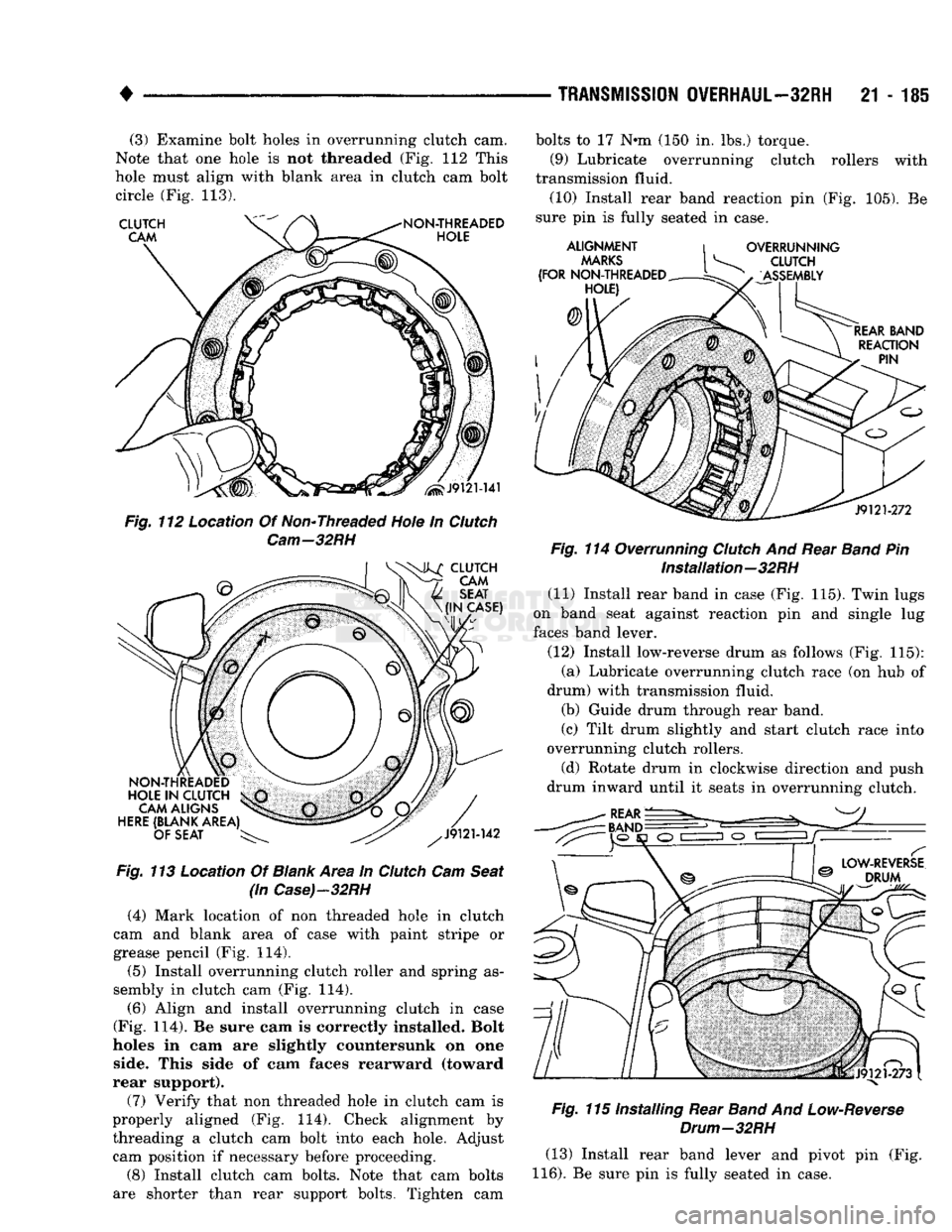
•
TRANSMISSION
OVERHAUL—32RH
21-185
(3) Examine bolt holes in overrunning clutch cam.
Note that one hole is not threaded (Fig. 112 This
hole must align with blank area in clutch cam bolt circle (Fig. 113).
Fig.
113 Location Of
Blank
Area in
Clutch
Cam
Seat
(in
Case)-32RH
(4) Mark location of non threaded hole in clutch
cam and blank area of case with paint stripe or
grease pencil (Fig. 114).
(5) Install overrunning clutch roller and spring as
sembly in clutch cam (Fig. 114).
(6) Align and install overrunning clutch in case
(Fig. 114). Be sure cam is correctly installed. Bolt
holes in cam are slightly countersunk on one side. This side of cam faces rearward (toward
rear support).
(7) Verify that non threaded hole in clutch cam is
properly aligned (Fig. 114). Check alignment by threading a clutch cam bolt into each hole. Adjust cam position if necessary before proceeding.
(8) Install clutch cam bolts. Note that cam bolts
are shorter than rear support bolts. Tighten cam bolts to 17 N»m (150 in. lbs.) torque.
(9) Lubricate overrunning clutch rollers with
transmission fluid. (10) Install rear band reaction pin (Fig. 105). Be
sure pin is fully seated in case.
Fig.
114 Overrunning
Clutch
And Rear
Band
Pin Installation—32RH
(11) Install rear band in case (Fig. 115). Twin lugs
on band seat against reaction pin and single lug
faces band lever.
(12) Install low-reverse drum as follows (Fig. 115): (a) Lubricate overrunning clutch race (on hub of
drum) with transmission fluid. (b) Guide drum through rear band.
(c) Tilt drum slightly and start clutch race into
overrunning clutch rollers.
(d) Rotate drum in clockwise direction and push
drum inward until it seats in overrunning clutch.
Fig.
115 Installing Rear
Band
And
Low-Reverse
Drum—32RH
(13) Install rear band lever and pivot pin (Fig.
116).
Be sure pin is fully seated in case.
Page 1187 of 1502
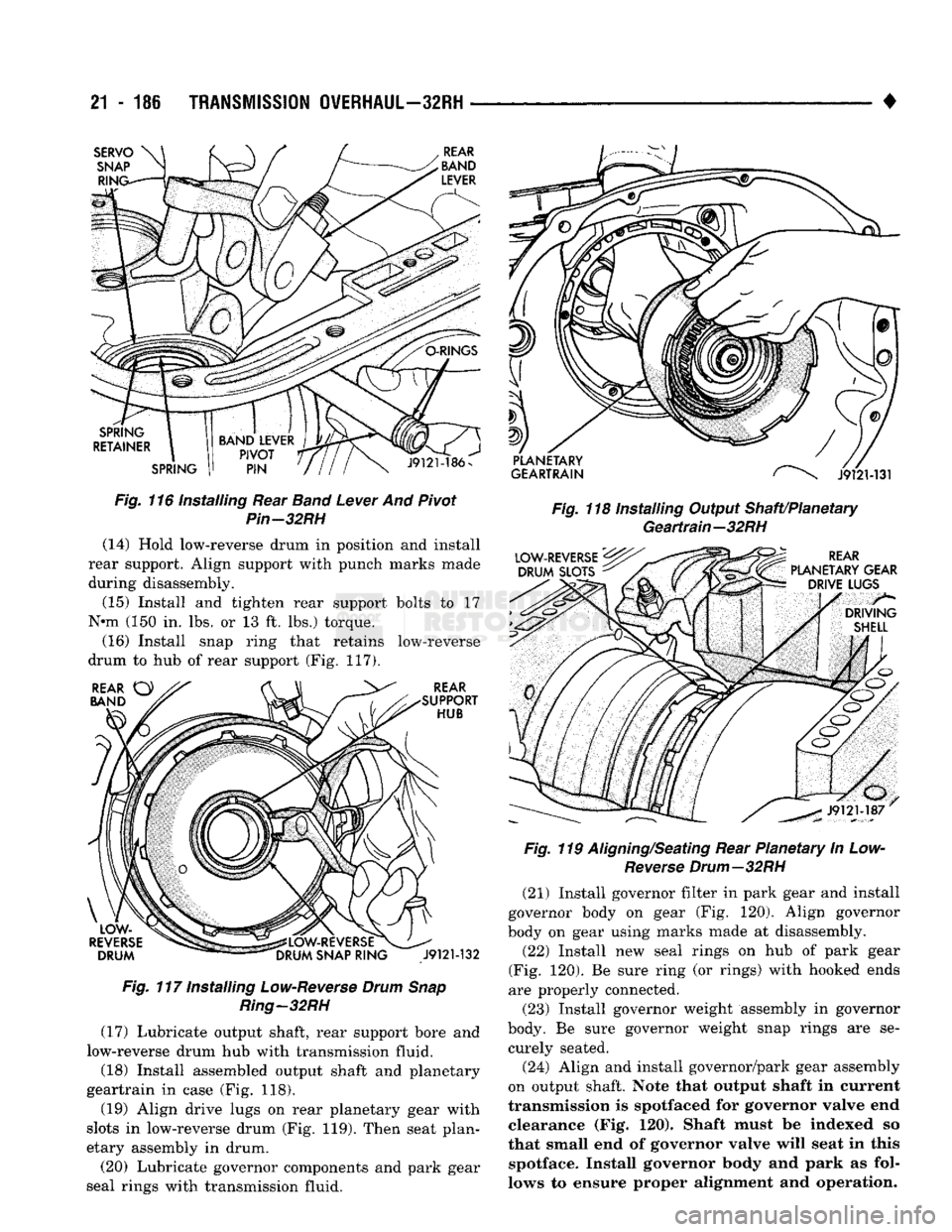
21
- 186
TRANSMISSION
OVERHAUL—32RH
Fig.
116 Installing Rear
Band
Lever
And Pivot
Pin-32RH
(14) Hold low-reverse drum in position and install
rear support. Align support with punch marks made
during disassembly.
(15) Install and tighten rear support bolts to 17
N*m (150 in. lbs. or 13 ft. lbs.) torque.
(16) Install snap ring that retains low-reverse
drum to hub of rear support (Fig. 117).
Fig.
117 Installing
Low-Reverse
Drum
Snap
Ring—32RH
(17) Lubricate output shaft, rear support bore and
low-reverse drum hub with transmission fluid. (18) Install assembled output shaft and planetary
geartrain in case (Fig. 118).
(19) Align drive lugs on rear planetary gear with
slots in low-reverse drum (Fig. 119). Then seat plan
etary assembly in drum.
(20) Lubricate governor components and park gear
seal rings with transmission fluid. •
Fig.
118 Installing Output Shaft/Planetary Geartrain—32RH
Fig.
119
Aligning/Seating
Rear Planetary In Low-
Reverse
Drum—32RH
(21) Install governor filter in park gear and install
governor body on gear (Fig. 120). Align governor
body on gear using marks made at disassembly.
(22) Install new seal rings on hub of park gear
(Fig. 120). Be sure ring (or rings) with hooked ends
are properly connected.
(23) Install governor weight assembly in governor
body. Be sure governor weight snap rings are se curely seated.
(24) Align and install governor/park gear assembly
on output shaft. Note that output shaft in current
transmission is spotfaced for governor valve end clearance (Fig. 120). Shaft must be indexed so
that small end of governor valve will seat in this spotface. Install governor body and park as fol
lows to ensure proper alignment and operation.
Page 1188 of 1502
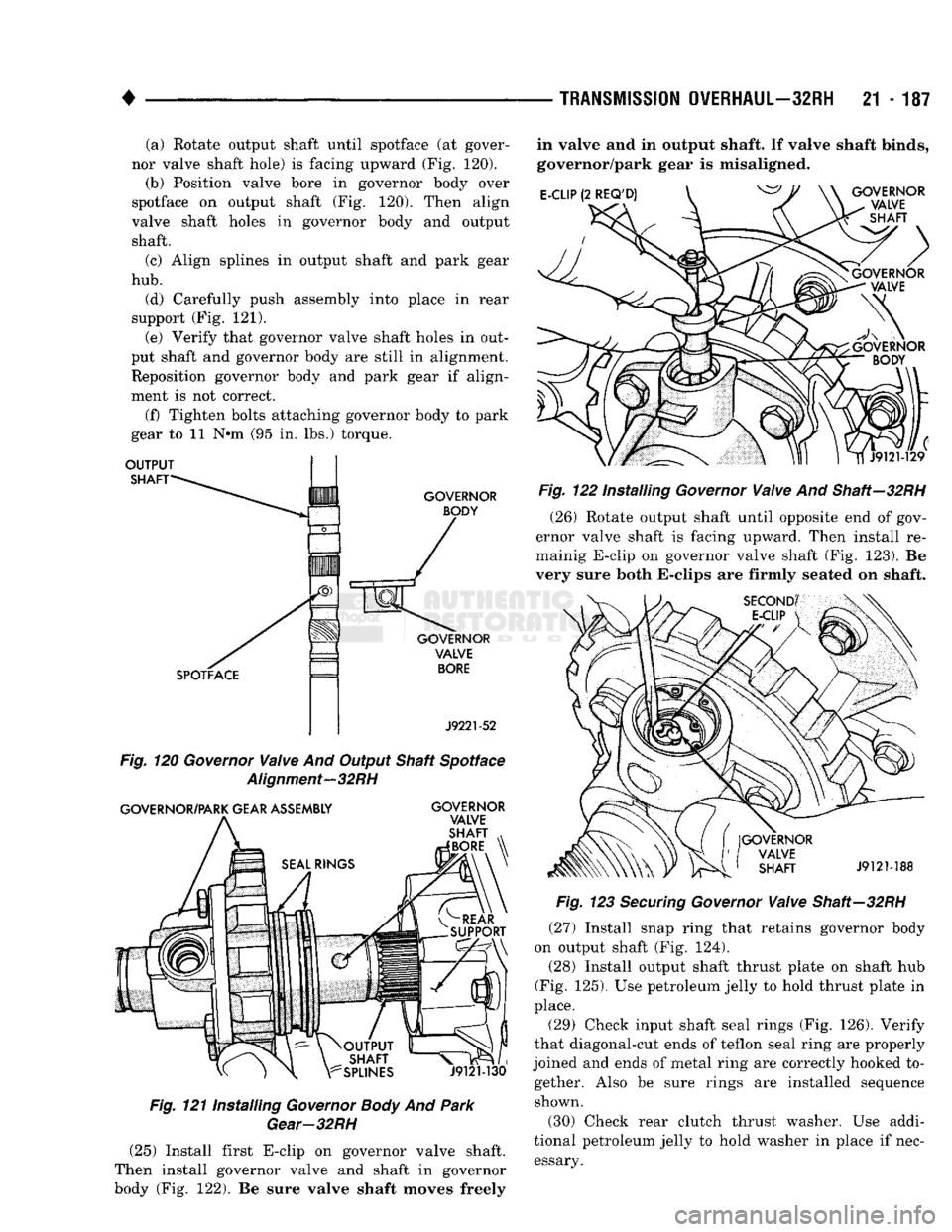
•
TRANSMISSION
OVERHAUL—32RH
21 - 187 (a) Rotate output shaft until spotface (at gover
nor valve shaft hole) is facing upward (Fig. 120). (b) Position valve bore in governor body over
spotface on output shaft (Fig. 120). Then align
valve shaft holes in governor body and output shaft.
(c) Align splines in output shaft and park gear
hub.
(d) Carefully push assembly into place in rear
support (Fig. 121). (e) Verify that governor valve shaft holes in out
put shaft and governor body are still in alignment.
Reposition governor body and park gear if align
ment is not correct.
(f) Tighten bolts attaching governor body to park
gear to 11 N*m (95 in. lbs.) torque.
OUTPUT
SHAFT
GOVERNOR BODY
GOVERNOR VALVE
BORE
J9221-52
Fig.
120
Governor
Valve
And Output Shaft Spotface
Alignment—32RH
GOVERNOR/PARK GEAR ASSEMBLY GOVERNOR
VALVE
SHAFT
BORE
J9121-130
Fig.
121 Installing
Governor
Body
And
Park
Gear-32RH
in valve and in output shaft. If valve shaft binds,
governor/park gear is misaligned.
E-CLIP
(2
REQ'D)
GOVERNOR
VALVE
\-
SHAFT
Fig.
122 Installing
Governor
Valve
And Shaft—32RH (26) Rotate output shaft until opposite end of gov
ernor valve shaft is facing upward. Then install re-
mainig E-clip on governor valve shaft (Fig. 123). Be
very sure both E-clips are firmly seated on shaft.
GOVERNOR VALVE SHAFT
J9121-188
Fig.
123
Securing
Governor
Valve
Shaft—32RH
(27) Install snap ring that retains governor body
on output shaft (Fig. 124).
(28) Install output shaft thrust plate on shaft hub
(Fig.
125).
Use petroleum jelly to hold thrust plate in
place.
(29) Check input shaft seal rings (Fig. 126). Verify
that diagonal-cut ends of teflon seal ring are properly
joined and ends of metal ring are correctly hooked to gether. Also be sure rings are installed sequence shown.
(30) Check rear clutch thrust washer. Use addi
tional petroleum jelly to hold washer in place if nec essary. (25) Install first E-clip on governor valve shaft.
Then install governor valve and shaft in governor
body (Fig. 122). Be sure valve shaft moves freely
Page 1189 of 1502
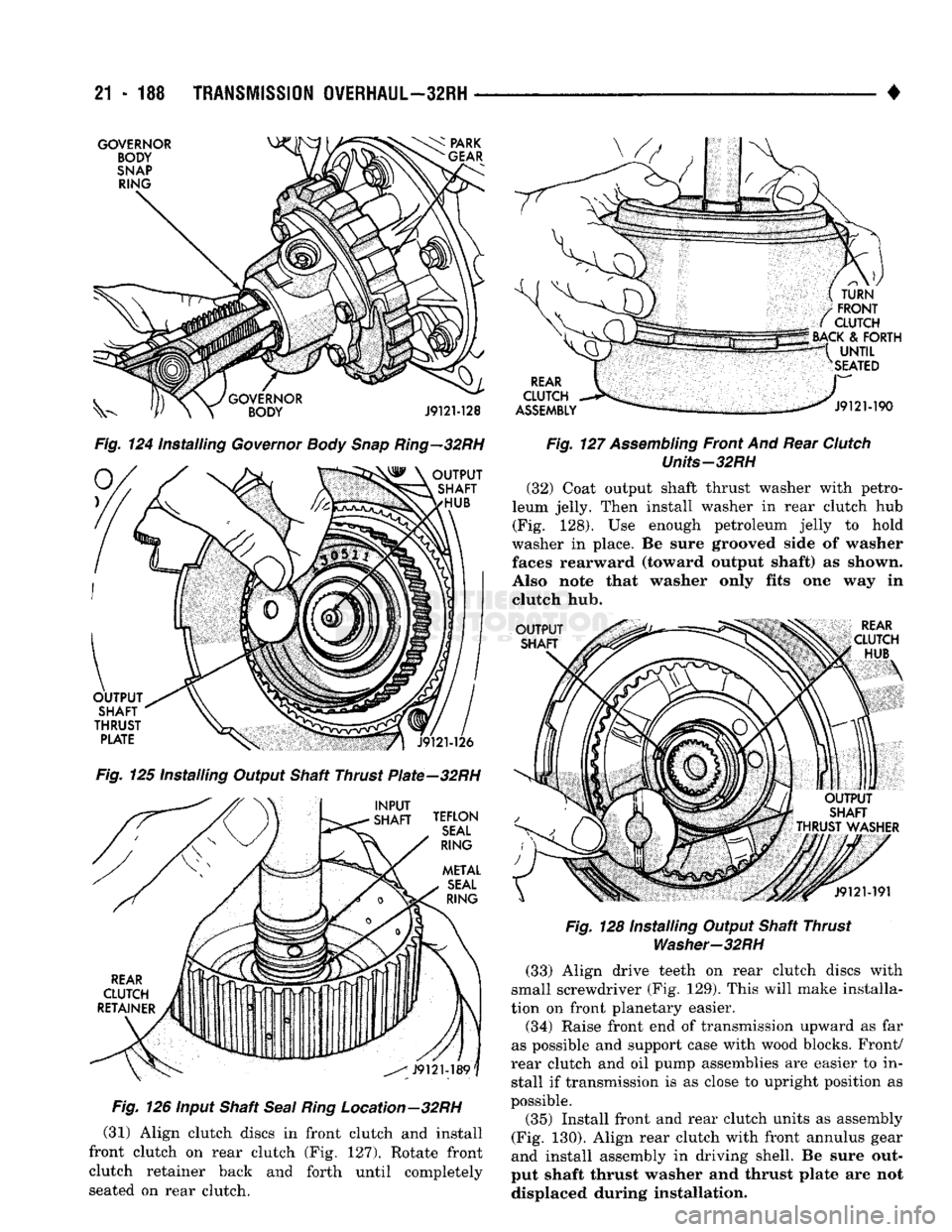
21
- 188
TRANSMISSION
OVERHAUL—32RH
•
Fig.
124 Installing
Governor
Body
Snap
Ring—32RH
Fig.
125 Installing Output Shaft Thrust PIate-32RH
Fig.
126 input Shaft
Seal
Ring
Location-32RH
(31) Align clutch discs in front clutch and install
front clutch on rear clutch (Fig. 127). Rotate front
clutch retainer back and forth until completely
seated on rear clutch.
Fig.
127
Assembling
Front And Rear
Clutch
Units-32RH
(32) Coat output shaft thrust washer with petro
leum jelly. Then install washer in rear clutch hub (Fig. 128). Use enough petroleum jelly to hold
washer in place. Be sure grooved side of washer faces rearward (toward output shaft) as shown.
Also note that washer only fits one way in clutch hub.
Fig.
128 Installing Output Shaft Thrust
Washer-32RH
(33) Align drive teeth on rear clutch discs with
small screwdriver (Fig. 129). This will make installa
tion on front planetary easier.
(34) Raise front end of transmission upward as far
as possible and support case with wood blocks. Front/
rear clutch and oil pump assemblies are easier to in stall if transmission is as close to upright position as
possible.
(35) Install front and rear clutch units as assembly
(Fig. 130). Align rear clutch with front annulus gear
and install assembly in driving shell. Be sure out
put shaft thrust washer and thrust plate are not displaced during installation.
Page 1190 of 1502
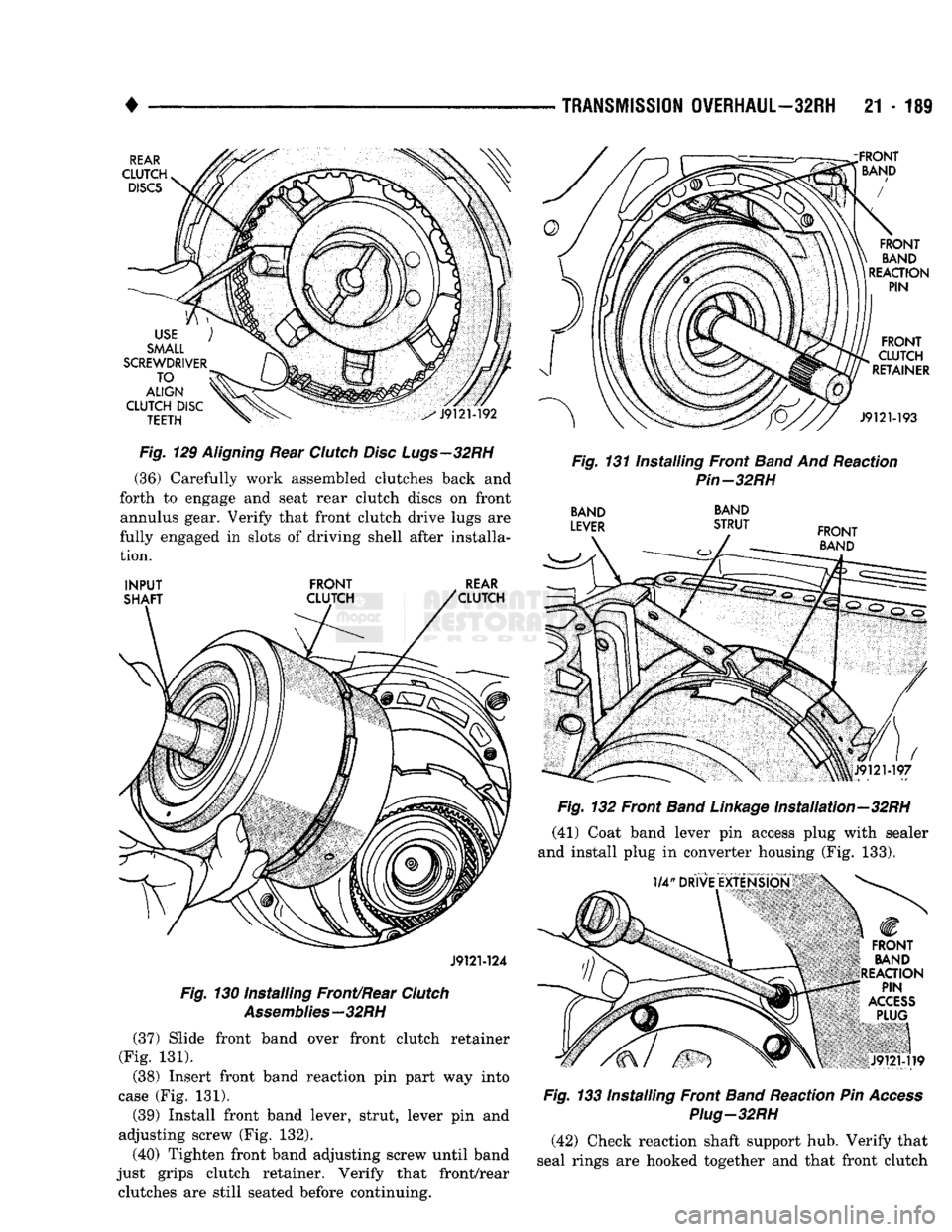
•
TRANSMISSION
OVERHAUL—32RH
21 - 189
Fig.
129
Aligning
Rear
Clutch
Disc Lugs—32RH
(36) Carefully work assembled clutches back and
forth to engage and seat rear clutch discs on front annulus gear. Verify that front clutch drive lugs are
fully engaged in slots of driving shell after installa
tion.
J9121-124
Fig.
130 Installing Front/Rear
Clutch
Assemblies—32RH
(37) Slide front band over front clutch retainer
(Fig. 131).
(38) Insert front band reaction pin part way into
case (Fig. 131). (39) Install front band lever, strut, lever pin and
adjusting screw (Fig. 132).
(40) Tighten front band adjusting screw until band
just grips clutch retainer. Verify that front/rear clutches are still seated before continuing.
Fig.
131 Installing Front
Band
And Reaction
Pin-32RH
BAND
BAND
Fig.
132 Front
Band
Linkage
Installation—32RH (41) Coat band lever pin access plug with sealer
and install plug in converter housing (Fig. 133).
Fig.
133 Installing Front
Band
Reaction Pin
Access
Plug-32RH
(42) Check reaction shaft support hub. Verify that
seal rings are hooked together and that front clutch